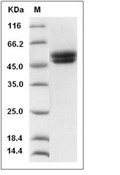Shopping Cart
Remove All Your shopping cart is currently empty
Your shopping cart is currently empty
RAGE Protein, Human, Recombinant (His) is expressed in HEK293 mammalian cells with His tag. The predicted molecular weight is 35.5 kDa and the accession number is A0A1U9X785.

| Pack Size | Price | USA Warehouse | Global Warehouse | Quantity |
|---|---|---|---|---|
| 5 μg | $48 | 7-10 days | 7-10 days | |
| 10 μg | $75 | 7-10 days | 7-10 days | |
| 20 μg | $118 | 7-10 days | 7-10 days | |
| 50 μg | $229 | 7-10 days | 7-10 days | |
| 100 μg | $386 | - | In Stock | |
| 200 μg | $682 | 7-10 days | 7-10 days | |
| 500 μg | $1,430 | 7-10 days | 7-10 days |
| Biological Activity | 1. Measured by its binding ability in a functional ELISA.
2. Immobilized recombinant human AGER-His at 10 μg/mL (100 μl/well) can bind biotinylated mouse His-S100A1 with a linear range of 15.6-250 ng/mL.
3. Measured by its ability to bind biotinylated human S100A1 in functional ELISA. |
| Description | RAGE Protein, Human, Recombinant (His) is expressed in HEK293 mammalian cells with His tag. The predicted molecular weight is 35.5 kDa and the accession number is A0A1U9X785. |
| Species | Human |
| Expression System | HEK293 Cells |
| Tag | C-His |
| Accession Number | Q15109-1 |
| Synonyms | RAGE,AGER,advanced glycosylation end product-specific receptor |
| Construction | A DNA sequence encoding the mature form of human AGER (NP_001127) extracellular domain (Met1-Ala 344) was expressed with a polyhistidine tag at the C-terminus. Predicted N terminal: Ala 23 |
| Protein Purity | > 98 % as determined by SDS-PAGE  |
| Molecular Weight | 35.5 kDa (predicted); 47-53 kDa (reducing conditions) |
| Endotoxin | < 1.0 EU/μg of the protein as determined by the LAL method. |
| Formulation | Lyophilized from a solution filtered through a 0.22 μm filter, containing PBS, pH 7.4. Typically, a mixture containing 5% to 8% trehalose, mannitol, and 0.01% Tween 80 is incorporated as a protective agent before lyophilization. |
| Reconstitution | A Certificate of Analysis (CoA) containing reconstitution instructions is included with the products. Please refer to the CoA for detailed information. |
| Stability & Storage | It is recommended to store recombinant proteins at -20°C to -80°C for future use. Lyophilized powders can be stably stored for over 12 months, while liquid products can be stored for 6-12 months at -80°C. For reconstituted protein solutions, the solution can be stored at -20°C to -80°C for at least 3 months. Please avoid multiple freeze-thaw cycles and store products in aliquots. |
| Shipping | In general, Lyophilized powders are shipping with blue ice. |
| Research Background | Receptor for Advanced Glycosylation End Products (RAGE, or AGER) is a member of the immunoglobulin super-family transmembrane proteins, as a signal transduction receptor which binds advanced glycation endproducts, certain members of the S100/calgranulin family of proteins, high mobility group box 1 (HMGB1), advanced oxidation protein products, and amyloid (beta-sheet fibrils). Initial studies investigating the role of RAGE in renal dysfunction focused on diabetes, neurodegenerative disorders, and inflammatory responses. However, RAGE also has roles in the pathogenesis of renal disorders that are not associated with diabetes, such as obesity-related glomerulopathy, doxorubicin-induced nephropathy, hypertensive nephropathy, lupus nephritis, renal amyloidosis, and ischemic renal injuries. RAGE represents an important factor in innate immunity against pathogens, but it also interacts with endogenous ligands, resulting in chronic inflammation. RAGE signaling has been implicated in multiple human illnesses, including atherosclerosis, arthritis, Alzheimer's disease, atherosclerosis and aging associated diseases. |
| Size | Quantity | Unit Price | Amount | Operation |
|---|

Copyright © 2015-2026 TargetMol Chemicals Inc. All Rights Reserved.